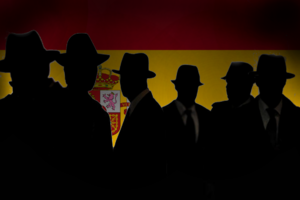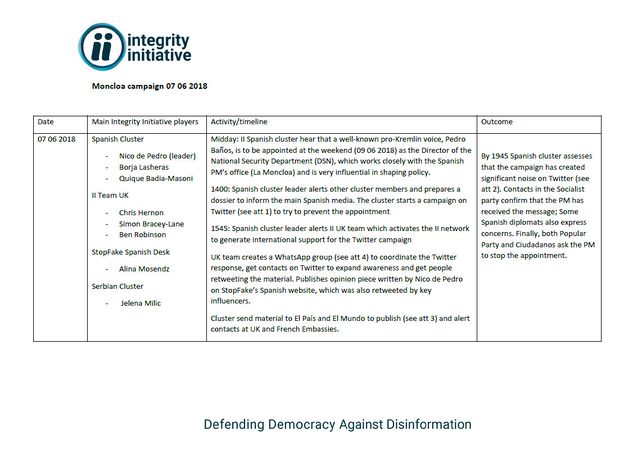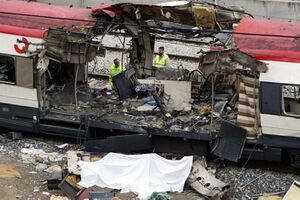Difference between revisions of "Spain/Deep state"
(Unstub) |
(→2010s: subsubsubsection) |
||
| (7 intermediate revisions by 2 users not shown) | |||
| Line 6: | Line 6: | ||
|abbreviation=ES/DS | |abbreviation=ES/DS | ||
|headquarters= | |headquarters= | ||
| − | |||
|description=The Spanish deep state | |description=The Spanish deep state | ||
}} | }} | ||
| − | '''The [[Spanish]] [[deep state]]''' can be understood as a continuation of the regime of [[Francisco Franco]]. It is class based in the bourgeoisie, the victors in the civil war 1936-39. After the democratization 1975-81, the civil service was never really reformed. The police, the army and the business leaders consisted of the same people. The new generation journalists and editors (see [[Juan Luis Cebrián]])and right wing politicians (see [[José María Aznar]]) were the sons and daughters of important people in the old regime, shedding the outward fascism, but never being in doubt of who should rule the state.{{cn}} | + | '''The [[Spanish]] [[deep state]]''' of today can be understood as a continuation of the regime of [[Francisco Franco]]. It is class based in the bourgeoisie, the victors in the civil war 1936-39. After the democratization 1975-81, the civil service was never really reformed. The police, the army and the business leaders consisted of the same people. The new generation journalists and editors (see [[Juan Luis Cebrián]]) and right wing politicians (see [[José María Aznar]]) were the sons and daughters of important people in the old regime, shedding the outward fascism, but never being in doubt of who should rule the state.{{cn}} |
| − | == | + | == 20th century == |
| − | + | === WW2 - Fascist haven === | |
| − | |||
| − | |||
| − | ===Fascist haven=== | ||
During the [[Cold War]], Spain was a hub and safe haven for fascist and nazi networks, including [[Operation Gladio]]. Former SS general [[Otto Skorzeny]] ran some of these connections from his asylum in Spain. | During the [[Cold War]], Spain was a hub and safe haven for fascist and nazi networks, including [[Operation Gladio]]. Former SS general [[Otto Skorzeny]] ran some of these connections from his asylum in Spain. | ||
These networks collaborated with the [[CIA]] in the fight against Communism. Italian fascist, after the failed [[Borghese Coup]] sought refuge in Spain. Some, such as [[Stefano delle Chiaie]] moved on with the help of the CIA to [[South America]], where they were employed by the intelligence agencies.<ref>https://midtifleisen.wordpress.com/2019/09/12/stefano-delle-chiaie-godfather-of-fascist-terrorism-and-cia-asset-dead-at-age-82/</ref> | These networks collaborated with the [[CIA]] in the fight against Communism. Italian fascist, after the failed [[Borghese Coup]] sought refuge in Spain. Some, such as [[Stefano delle Chiaie]] moved on with the help of the CIA to [[South America]], where they were employed by the intelligence agencies.<ref>https://midtifleisen.wordpress.com/2019/09/12/stefano-delle-chiaie-godfather-of-fascist-terrorism-and-cia-asset-dead-at-age-82/</ref> | ||
| − | ==1970s== | + | ===Post WW2=== |
| + | The military cooperation with the US and NATO during the [[Cold War]] created structures that run parallel to the elected government.{{cn}} | ||
| + | |||
| + | === 1960s === | ||
| + | === 1970s === | ||
[[Death squads]] were used against Basque separatists, killing several hundreds in the 1970-80s, both under the Franco regime and the elected governments. [[Stefano delle Chiaie]] worked for one of them for a few years. Also the Social Democrat government of [[Felipe Gonzalez]] used them. | [[Death squads]] were used against Basque separatists, killing several hundreds in the 1970-80s, both under the Franco regime and the elected governments. [[Stefano delle Chiaie]] worked for one of them for a few years. Also the Social Democrat government of [[Felipe Gonzalez]] used them. | ||
| + | === 1980s === | ||
| + | === 1990s === | ||
| − | ==2010s== | + | == 21st century == |
| + | === 2000s === | ||
| + | [[image:Madrid train.jpg|right|300px|thumbnail|The remains of a bombed train.]] | ||
| + | The [[2004 Madrid train bombings]] killed 191 people on 11 March, and was officially blamed on [[Al Qaeda]]. [[NATO Secretary General]], [[Jaap de Hoop Scheffer]], who was in Madrid on 1 March described it as a "coincidence" that a 4 March "[[counter-terrorism]]" exercise anticipated killing 200 people, finishing just a few hours before the bombings.<ref>http://aangirfan.blogspot.com/2010/10/nato-link-to-madrid-bombings-of-2004.html</ref> | ||
| + | |||
| + | === 2010s=== | ||
| + | ====|2017 Barcelona attacks ==== | ||
| + | {{FA|2017 Barcelona attacks}} | ||
| + | The [[2017 Barcelona attacks]], a series of terrorist attacks in the Spanish region of [[Catalonia]], killing 16 civilians and injuring 152, was revealed to be the result of intimate connections between an Islamist cell and Spanish [[intelligence agencies]].{{cn}} | ||
[[image:Integrity Initiative Moncloa campaign.jpg|left|642px|thumbnail|A timeline of the [[Moncloa campaign]], a covert smear campaign by the [[Integrity Initiative's Spanish cluster]] to block the appointment of [[Pedro Baños]] as [[Director of the Spanish Department of Homeland Security]] on grounds of alleged pro-Kremlin sympathies. This document was part of the [[first Integrity Initiative leak]], released in November 2018.]] | [[image:Integrity Initiative Moncloa campaign.jpg|left|642px|thumbnail|A timeline of the [[Moncloa campaign]], a covert smear campaign by the [[Integrity Initiative's Spanish cluster]] to block the appointment of [[Pedro Baños]] as [[Director of the Spanish Department of Homeland Security]] on grounds of alleged pro-Kremlin sympathies. This document was part of the [[first Integrity Initiative leak]], released in November 2018.]] | ||
| + | |||
| + | ===Integrity Initiative Spanish Cluster=== | ||
| + | {{FA|Integrity Initiative/Cluster/Spain}} | ||
| + | In 2017, the [[Institute for Statecraft]] began a process of metastasis in the form of the [[Integrity Initiative Clusters]], which we [[compartmentalised]] cells controlled from HQ in London. The first cluster to be set up, in January 2017,<ref>[[Document:Progress report on establishing national clusters]]</ref> was the Spanish cluster, exposed by the [[first Integrity Initiative Leak]] in November 2018. | ||
| + | |||
| + | == Exposure == | ||
| + | In 2021, ex-President of Catalonia [[Carles Puigdemont]] made the point that the Spanish deep state of today is the same as the [[Franco]]-era deep state.<ref>https://www.rt.com/shows/going-underground/518621-puigdemont-spain-catalonia-independence/</ref> | ||
==People== | ==People== | ||
Revision as of 15:52, 22 February 2023
(Deep state) | |
|---|---|
 | |
| Abbreviation | ES/DS |
| Exposed by | Mario Conde |
| The Spanish deep state | |
The Spanish deep state of today can be understood as a continuation of the regime of Francisco Franco. It is class based in the bourgeoisie, the victors in the civil war 1936-39. After the democratization 1975-81, the civil service was never really reformed. The police, the army and the business leaders consisted of the same people. The new generation journalists and editors (see Juan Luis Cebrián) and right wing politicians (see José María Aznar) were the sons and daughters of important people in the old regime, shedding the outward fascism, but never being in doubt of who should rule the state.[citation needed]
Contents
20th century
WW2 - Fascist haven
During the Cold War, Spain was a hub and safe haven for fascist and nazi networks, including Operation Gladio. Former SS general Otto Skorzeny ran some of these connections from his asylum in Spain.
These networks collaborated with the CIA in the fight against Communism. Italian fascist, after the failed Borghese Coup sought refuge in Spain. Some, such as Stefano delle Chiaie moved on with the help of the CIA to South America, where they were employed by the intelligence agencies.[1]
Post WW2
The military cooperation with the US and NATO during the Cold War created structures that run parallel to the elected government.[citation needed]
1960s
1970s
Death squads were used against Basque separatists, killing several hundreds in the 1970-80s, both under the Franco regime and the elected governments. Stefano delle Chiaie worked for one of them for a few years. Also the Social Democrat government of Felipe Gonzalez used them.
1980s
1990s
21st century
2000s
The 2004 Madrid train bombings killed 191 people on 11 March, and was officially blamed on Al Qaeda. NATO Secretary General, Jaap de Hoop Scheffer, who was in Madrid on 1 March described it as a "coincidence" that a 4 March "counter-terrorism" exercise anticipated killing 200 people, finishing just a few hours before the bombings.[2]
2010s
|2017 Barcelona attacks
- Full article: 2017 Barcelona attacks
- Full article: 2017 Barcelona attacks
The 2017 Barcelona attacks, a series of terrorist attacks in the Spanish region of Catalonia, killing 16 civilians and injuring 152, was revealed to be the result of intimate connections between an Islamist cell and Spanish intelligence agencies.[citation needed]

Integrity Initiative Spanish Cluster
- Full article: Integrity Initiative/Cluster/Spain
- Full article: Integrity Initiative/Cluster/Spain
In 2017, the Institute for Statecraft began a process of metastasis in the form of the Integrity Initiative Clusters, which we compartmentalised cells controlled from HQ in London. The first cluster to be set up, in January 2017,[3] was the Spanish cluster, exposed by the first Integrity Initiative Leak in November 2018.
Exposure
In 2021, ex-President of Catalonia Carles Puigdemont made the point that the Spanish deep state of today is the same as the Franco-era deep state.[4]
People
- Juan Luis Cebrián - Media mogul, Bilderberg steering committee, has attended more Bilderbergs than any other Spaniard
- Jaime Carvajal Urquijo - Another Spanish Bilderberg steering committee member
- Matías Rodríguez Inciarte - 13 Bilderbergs, former Bilderberg steering committee member
- Spanish Bilderbergers
References
- ↑ https://midtifleisen.wordpress.com/2019/09/12/stefano-delle-chiaie-godfather-of-fascist-terrorism-and-cia-asset-dead-at-age-82/
- ↑ http://aangirfan.blogspot.com/2010/10/nato-link-to-madrid-bombings-of-2004.html
- ↑ Document:Progress report on establishing national clusters
- ↑ https://www.rt.com/shows/going-underground/518621-puigdemont-spain-catalonia-independence/
